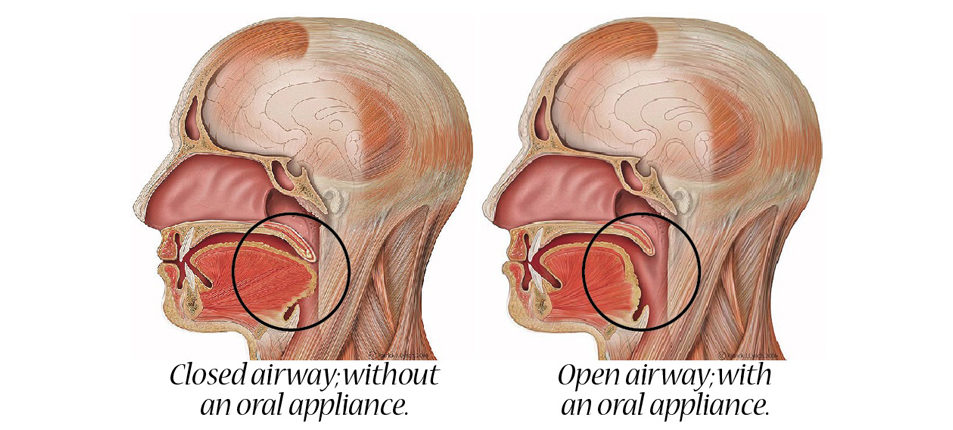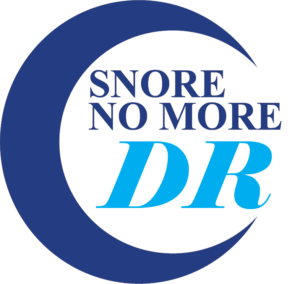What is Obstructive Sleep Apnea (OSA)?
Definition: Intermittent airflow blockage during sleep.
Obstructive sleep apnea, also known as OSA, is a sleep disorder in which the person stops breathing for at least 10 seconds each hour during sleep. It is caused by relaxation of the throat muscles; the soft tissue in the back of the throat collapses and closes, resulting in a blocked airway. Snoring and OSA are common problems that can affect your sleep, health, and have a significant impact on your quality of life. Often snoring is a sign of OSA but not necessarily a symptom. Momentary suffocation develops causing excessive stress on the body. As a result, there is reduced oxygenation to the brain, heart, and muscles.
Obstructive sleep apnea is seen in all age groups, but the frequency increases with age and obesity.
Snoring & Sleep Apnea
Snoring is a sound that occurs in the upper airway as you breathe. This sound is a sign that your airway is partially blocked, usually by the soft tissue in your throat. The flow of air causes the soft tissue to vibrate, creating sound, which comes out of your nose, mouth or both. Snoring is considered by experts as a major indicator of obstructive sleep apnea (OSA). Although you snore, it doesn’t necessarily mean you have sleep apnea, and vice versa.

WHY IS SNORING SERIOUS?
Socially
Snoring can make the snorer an object of ridicule and can cause the bed partner to experience sleepless nights and fatigue.
Medically
It disturbs sleeping patterns and deprives the snorer of adequate rest. It may be a sign of obstructive sleep apnea (OSA), which can lead to serious, long-term health problems.
Signs and Symptoms
Common signs of OSA include unexplained daytime sleepiness, restless sleep, and loud snoring (with periods of silence followed by gasps). Less common symptoms are morning headaches; insomnia; trouble concentrating; mood changes such as irritability, anxiety and depression; forgetfulness; increased heart rate and/or blood pressure; decreased sex drive; unexplained weight gain; increased urination and/or nocturia; frequent heartburn or gastroesophageal reflux disease; and heavy night sweats.
Regardless of age, untreated obstructive sleep apnea can lead to serious complications, including cardiovascular disease, accidents, and premature death. So it’s important that anyone with signs and symptoms of obstructive sleep apnea — especially loud snoring and repeated nighttime awakenings followed by excessive daytime sleepiness — receive appropriate medical evaluation.
Major signs and symptoms of sleep apnea
- Loud and chronic snoring
- Choking or gasping during sleep
- Pauses in breathing
- Waking up at night feeling short of breath
- Daytime sleepiness and fatigue
Other warning signs and symptoms of sleep apnea
- Waking up with a dry mouth or sore throat
- Insomnia or nighttime awakenings
- Going to the bathroom frequently during the night
- Forgetfulness and difficulty concentrating
- Uncharacteristic moodiness, irritability, or depression
- Morning headaches
- Restless sleep
- Impotence
Causes of Obstructive Sleep Apnea
Obstructive sleep apnea is a common and serious disorder in which breathing repeatedly stops for 10 seconds or more while you are sleeping. The disorder results in decreased oxygen in the blood and can briefly awaken sleepers throughout the night. Sleep apnea has many different possible causes.
In adults, the most common cause of obstructive sleep apnea is excess weight and obesity, which is associated with soft tissue of the mouth and throat. During sleep, when throat and tongue muscles are more relaxed, this soft tissue can cause the airway to become blocked. But many other factors also are associated with the condition in adults.
In addition to obesity, other anatomical features associated with obstructive sleep apnea — many of them hereditary — include a narrow throat, thick neck, and a round head. Contributing factors may include hypothyroidism, excessive and abnormal growth due to excessive production of growth hormone (acromegaly), and allergies and other medical conditions such as a deviated septum that cause congestion in the upper airways.
In adults, smoking, excessive alcohol use, and/or the use of sedatives is often associated with obstructive sleep apnea.
Possible Complications Associated With OSA
Many patients discover they are suffering from sleep apnea when they notice they wake up in the morning tired and unrefreshed, or they awoke during the night choking or gasping for air. Later in the day, a patient might suffer from unusual daytime sleepiness which increases the risk for motor vehicle accidents and depression. Increasing evidence suggests that obstructive sleep apnea is strongly associated with conditions such as high blood pressure (hypertension), stroke, heart attack, diabetes, gastroesophageal reflux disease, nocturnal angina, heart failure, hypothyroidism, and an abnormal heart rhythm. About half of sleep-apnea patients have hypertension, and untreated obstructive sleep apnea increases the risk of heart-related illness and death. Some complications may be related to the release of stress hormones, which may be triggered by frequent decreases in blood oxygen levels and reduced sleep quality. Stress hormones can increase heart rate and also can lead to the development or worsening of heart failure.
Other maladies caused by OSA include headaches and memory loss. Sleep apnea also puts people at risk of cardiovascular conditions such as hypertension, heart disease and stroke. Diabetes, congestive heart failure, arrhythmia, and atrial fibrillation can also occur. People with an obstructive apnea are more likely to die earlier, (life expectancy is 55) according to the American Heart Association.
